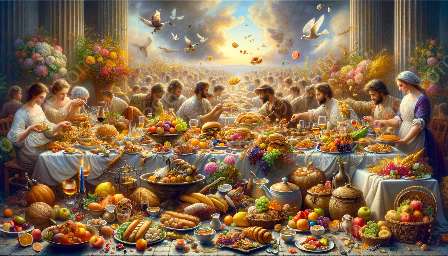Food has always been a universal language, transcending cultural barriers and serving as a metaphor for life, love, and human experience in literature. Throughout history, writers have skillfully utilized food metaphors and allegories to convey deeper meanings, add layers of complexity to their narratives, and provide insight into unique cultural and historical perspectives.
Significance of Food Metaphors and Allegories in Literature
Food metaphors and allegories play a significant role in literature, enriching the text with symbolism and portraying the human experience in a relatable and sensory manner. Writers often use food-related descriptions to evoke emotions, create vivid imagery, and cultivate a deeper connection between the reader and the narrative.
Food metaphors and allegories are particularly effective in expressing complex emotions, desires, and societal dynamics. By drawing parallels between food and human experiences, writers can communicate profound messages that resonate with readers across diverse backgrounds.
Impact of Food Metaphors and Allegories in Shaping Food Culture
The utilization of food metaphors and allegories in literature has greatly influenced food culture, as it highlights the culinary traditions, values, and perceptions of different societies. Literary works often serve as a reflection of historical food practices and the societal significance of certain foods, contributing to the shaping of food culture.
Furthermore, food metaphors in literature have the power to inspire culinary creativity and innovation. They encourage readers to explore the sensory and emotional dimensions of food, fostering an appreciation for culinary artistry and the cultural heritage associated with various cuisines.
Exploring the Connection Between Food in Literature and Art
Food has long been a recurring motif in both literature and art, serving as a source of inspiration for creatives across different mediums. The convergence of food in literature and art is evident in the portrayal of food-related themes in paintings, sculptures, and other visual forms of artistic expression.
Artists often draw from literary references to depict the sensory and symbolic aspects of food, blurring the lines between the written word and visual representation. This interconnectedness enriches the artistic experience, as it allows for a multi-dimensional exploration of food's cultural, historical, and emotional significance.
Understanding the Interplay of Food Culture and History
Food culture and history are deeply intertwined with literature, as literary works often serve as valuable sources for understanding the culinary practices and social contexts of different time periods. By examining food metaphors and allegories in literature, one can gain insight into the evolution of food culture and its intrinsic connection to historical developments.
Furthermore, the exploration of food culture and history through literature enables readers to appreciate the diverse culinary landscapes that have shaped human societies throughout the ages. It offers a window into the rituals, traditions, and symbolic meanings associated with food, providing a comprehensive understanding of how food has been woven into the fabric of human civilization.
Conclusion
Food metaphors and allegories in literature serve as powerful vehicles for expressing the richness of human experiences, shedding light on cultural nuances, and shaping food culture. Their interplay with food in literature and art, along with their deep-rooted connection to food culture and history, further amplifies their significance in transcending mere sustenance and delving into the realms of emotion, symbolism, and communal identity.

